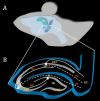Cardiovascular Fitness and Cognitive Spatial Learning in Rodents and in Humans
- PMID: 25227128
- PMCID: PMC4536905
- DOI: 10.1093/gerona/glu162
Cardiovascular Fitness and Cognitive Spatial Learning in Rodents and in Humans
Abstract
The association between cardiovascular fitness and cognitive functions in both animals and humans is intensely studied. Research in rodents shows that a higher cardiovascular fitness has beneficial effects on hippocampus-dependent spatial abilities, and the underlying mechanisms were largely teased out. Research into the impact of cardiovascular fitness on spatial learning in humans, however, is more limited, and involves mostly behavioral and imaging studies. Herein, we point out the state of the art in the field of spatial learning and cardiovascular fitness. The differences between the methodologies utilized to study spatial learning in humans and rodents are emphasized along with the neuronal basis of these tasks. Critical gaps in the study of spatial learning in the context of cardiovascular fitness between the two species are discussed.
Keywords: Cardiovascular fitness; Exercise; Hippocampus; Navigation; Spatial learning.
© The Author 2014. Published by Oxford University Press on behalf of The Gerontological Society of America.
Figures


References
-
- Spirduso WW, Clifford P. Replication of age and physical activity effects on reaction and movement time. J Gerontol. 1978;33:26–30. - PubMed
-
- Colcombe S, Kramer AF. Fitness effects on the cognitive function of older adults: a meta-analytic study. Psychol Sci. 2003;14:125–130. - PubMed
-
- Fahey TD, Insel PM, Roth WT. Fit & well: core concepts and labs in physical fitness and wellness. 9th ed. New York, NY: McGraw-Hill; 2011. doi:10.1036/0072529776
-
- Kenney WL. Parasympathetic control of resting heart rate: relationship to aerobic power. Med Sci Sports Exerc. 1985;17:451–455. doi:10.1249/00005768-198508000-00008 - PubMed
MeSH terms
Substances
LinkOut - more resources
Full Text Sources
Other Literature Sources
Medical

